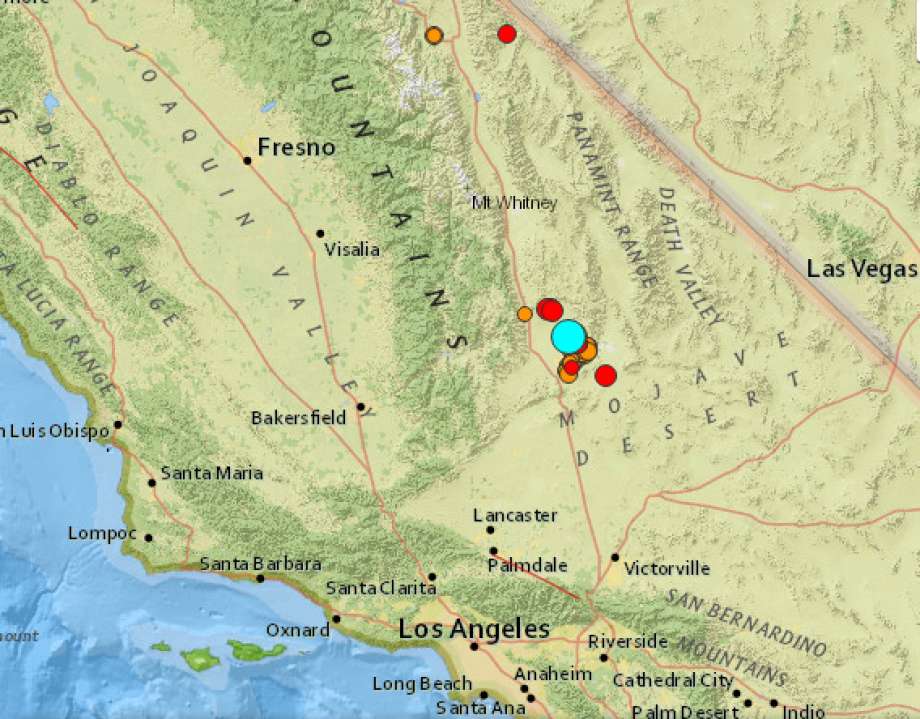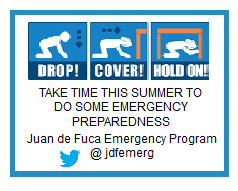
Friday, July 5, 2019 ~ BC
~ West Shore Voice News
A 6.4 Magnitude earthquake in southern California on Thursday July 4 was followed by a 5.4 aftershock quake early Friday morning, then a 7.1 quake along the same fault line this evening, July 5, at around 8:19 pm. Yesterday’s quake is now being called a ‘foreshock’.
Relief of seismic stress is apparently generally not the case after a quake. Earthquakes are followed by aftershocks that usually of lesser magnitude, but also tend to increase the risk of future quakes.

The San Andreas fault where the California quakes occured in the last two days is over 800 miles (1,288 km) long. The southern portion of the fault between Monterey County and the Mexican border is apparently capable of producing a magnitude 8.2 quake. Los Angeles, San Diego and Santa Barbara are situated along that fault.
Thursday’s quake struck at 10:33 a.m., and was the largest temblor to strike the region in 20 years, until Friday night. According to the United States Geological Survey (USGS), a 7.1-magnitude earthquake is 11 times stronger than the 6.4 earthquake.
The epicenter of tonight’s quake was 10.5 miles away from Ridgecrest, Calif., and there were no immediate reports of damage or injuries. According to the USGS, the quake was felt as far north as San Jose and as far south as parts of Mexico.

On Vancouver Island we are in an active seismic zone. There was a Magnitude 6.2 earthquake with its epicentre 221 km from Port Hardy two days ago on Wednesday July 3 at 9:30 pm.
As well, three earthquakes of 4.7 to 5.1 magnitude were detected north of Vancouver Island this morning, July 5.
According to Earthquakes Canada, the aftershocks to Wednesday’s quake struck south of Haida Gwaii starting at 5:51 am. The second quake was reported at 5:58 am and the third at 6:02 am. Earthquakes Canada said the first had a magnitude of 4.9, the second was 5.1 and the third was 4.7.
The usual probability statistic is that ‘the big one’ — a quake with a magnitude of 9.0 or greater — is likely to occur with 30% probability in the next 50 years on Vancouver Island and coastal BC regions where the Juan de Fuca plate is moving towards and under the North American plate, in an area known as the Cascadia Subduction Zone. This zone can produce megathrust quakes which may register greater than magnitude 9.0.
According to the Pacific Northwest Seismic Network, in the Pacific Northwest movement of three tectonic plates drive our regional earthquake hazard. The Pacific Plate is moving to the northwest at a speed of between 7 and 11 centimeters (cm) or about 3 to 4 inches a year.
The Capital Regional District offers earthquake preparedness information online, within their www.prepareyourself.ca portal. What many people may not realize that immediate help is likely not available to most people all too promptly after a major catastrophe event.
Emergency kits should be stored at home, in your car, and at work. Everyone in your family should share a plan for what to do in an emergency and where to meet afterward if in separate locations when an emergency happens.
While there will be Emergency Operations Centres (EOCs) in many communities, people should be prepared to survive on their own for at least seven days as most services and supply networks will be interrupted or unavailable after a major quake. Basics include food supply, water for people and pets, medications for people and pets, first aid supplies, batteries (for radio, lamps, heating devices), blankets, cash on hand (digital access to money may be unavailable), and much more.

Hoping to be notified of a major emergency? First of all, if the ground shakes so badly that you can’t stand up, you don’t need an alert. It’s an earthquake.
Otherwise, residents will find various levels of emergency alert services in their municipalities. Check Alert Ready for general information about major disaster announcements, and your local municipal website for how to be advised of a disaster, including West Shore Alert in Langford, Colwood, View Royal, Highlands and Sooke.


